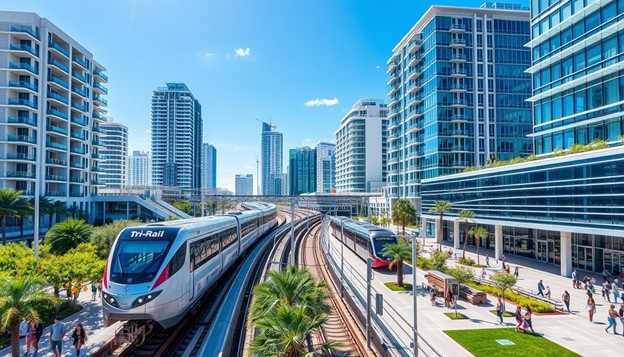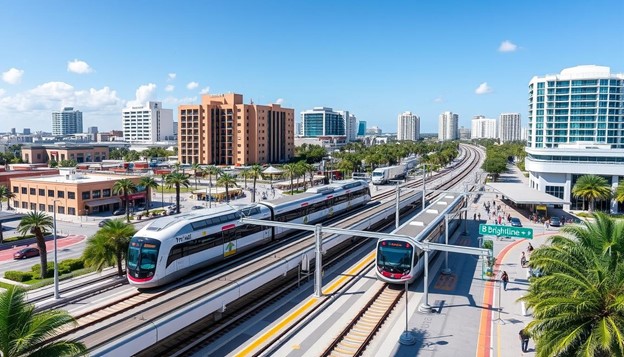The Sunshine State’s transit scene is changing fast. The Tri-Rail and Brightline expansions are leading the way. They’re making areas near transit hubs more appealing for new projects.
These investments are turning these spots into hubs for both work and living. South Florida’s urban landscape is getting a big makeover.

Key Takeaways
- Tri-Rail and Brightline expansions are fueling higher-density developments near transit hubs in Florida.
- These transit-oriented projects are making the areas more appealing for commercial and residential development.
- The integration of public transportation with urban planning is reshaping the communities of South Florida.
- Increased accessibility and connectivity are driving property value growth near transit stations.
- The economic benefits of transit-oriented development are becoming more evident in the region.
The Evolution of South Florida’s Transit Landscape
South Florida’s transportation history shows a steady move towards better and more connected transit systems. The tri-rail project and brightline expansion have been key in shaping this landscape. They are leading the way for a future with better transit and infrastructure.
Historical Development of Regional Rail Systems
The Tri-County Commuter Rail system, now Tri-Rail, started in the late 1980s. It has grown, connecting big hubs and helping commuters in Broward, Miami-Dade, and Palm Beach counties.
Current Transportation Challenges
Even with Tri-Rail’s growth, South Florida still faces traffic jams and the need for better public transport. The area’s car use has increased carbon emissions. New solutions are needed to tackle these issues.
Vision for Connected Communities
The future of South Florida’s transit aims for a system that links everything together. The brightline expansion and ongoing transit investments aim to make this happen. They want to offer people many ways to travel sustainably.
“The vision for South Florida is to build a transit-oriented future that reduces our reliance on private vehicles and fosters more livable, sustainable communities.”
With the tri-rail project, brightline expansion, and other investments, South Florida is set to change its transport landscape. It’s moving towards a more connected and green future.

Understanding Tri-Rail’s Expansion Strategy
The Tri-Rail project is key to South Florida’s growing transportation needs. It aims to link communities, boost access, and support green urban growth. This plan is vital for better transit and more people living near transit points.
Tri-Rail wants to grow its rail network in Palm Beach, Broward, and Miami-Dade counties. It plans to add new routes, upgrade stations, and link with buses and ridesharing. This will make travel easier and more efficient.
Developers are taking notice of the Tri-Rail’s growth. They’re building more homes, shops, and mixed-use projects near stations. These projects will benefit from better rail service, making life easier for residents.
More transit-oriented developments are popping up along the rail line. These include mixed-use buildings and revitalized city centers. They’re changing how people live, work, and travel in South Florida.
As Tri-Rail grows, so will the area’s density. More projects will use the improved transit system. This will make travel and living in South Florida even better.
Brightline’s Revolutionary Impact on Regional Connectivity
The Brightline high-speed rail project is changing how people travel in South Florida. It’s expanding from Miami to Orlando, making travel easier and opening up new opportunities for growth.
Miami to Orlando Route Development
Brightline plans to extend its service from Miami to Orlando, a distance of about 235 miles. This will link Miami, Fort Lauderdale, West Palm Beach, and Central Florida. It will cut travel time between Miami and Orlando to under 3 hours, making it a better choice than driving.
Station Location Strategy
Brightline’s stations are placed to make the most of its investments. They will be in major cities, connecting well with local transport. This strategy aims to boost growth around these hubs, creating lively, walkable areas.
Economic Impact Assessment
The Brightline expansion will have a big economic effect. It’s expected to create over $6 billion in economic activity and thousands of jobs during construction. It will also make areas more attractive to businesses and people, boosting local economies.
“Brightline’s vision is to transform the way people move throughout Florida, connecting major urban centers and supporting the development of sustainable, transit-oriented communities.”
Transit and Infrastructure Investments Reshaping Florida
Florida is changing fast, thanks to big investments in transit and infrastructure. These efforts are making it easier to get around and creating denser areas near transit stops. This change is making the state’s cities more vibrant, offering new ways to live and work.
The growth of transit systems like Tri-Rail and Brightline is key to this change. These systems link big cities, making travel easy and quick. This has led to the creation of lively, mixed-use communities near transit stops. These places are designed for people who want to walk and live sustainably.
“The integration of transit and infrastructure investments is not just about improving mobility – it’s about fostering the development of dynamic, livable communities that attract and retain top talent.”
These investments are also boosting the economy. They’re making it easier to build denser areas near transit, drawing in businesses and people. This creates jobs and strengthens the local economy.
As Florida keeps growing, its cities will change even more. The smart use of transit and infrastructure will bring better connectivity, livability, and economic growth.
Higher-Density Development Trends Near Transit Hubs
South Florida’s transportation is changing fast. The area is seeing more high-density projects near transit hubs. These projects are changing how we live, work, and travel. They mix homes, offices, and fun spaces together.
Mixed-Use Project Examples
The MiamiCentral project is a great example. It’s near the Brightline train station in downtown Miami. It has tall apartments, offices, shops, and public areas. It’s a lively place for people to live, work, and play.
Property Value Implications
Living near transit hubs can make homes and businesses more valuable. Studies show homes and businesses near transit stations cost more. This shows how desirable and convenient these areas are.
Urban Planning Integration
- Urban planners in South Florida are using transit-oriented development in their plans. They see the good it does for the area.
- By matching transportation with land use, cities are making better, greener, and more prosperous places. They mix transit, homes, and businesses well.
- This smart planning makes the area more connected. It also uses land and resources better and in a greener way.
As South Florida keeps investing in transit and infrastructure, more high-density projects near transit hubs will appear. This will change the area’s look and start a new era of living close to transit.
Economic Benefits of Transit-Oriented Development
Florida is seeing big changes thanks to its transit and infrastructure investments. These changes are creating new jobs and bringing in more tax money for local governments. This is a big win for the state’s economy.
Places near transit hubs are becoming hubs for businesses. You’ll find everything from shops and restaurants to tech companies. This growth means more jobs and more money for local taxes.
These transit networks also make life better for people living nearby. They get to spend less time commuting and have easier access to shops and services. This makes cities more lively and attractive places to live.
“The economic benefits of transit-oriented development extend far beyond just the transit system itself. These investments catalyze broader economic growth and revitalization, benefiting the entire region.”
Studies from Florida show how much transit development helps the economy. For example, Miami’s Brightline stations have brought in over $3 billion. They’ve also created thousands of jobs and boosted local taxes. Tri-Rail’s expansion has led to more mixed-use projects, drawing in new businesses and residents.
Florida’s focus on transit and infrastructure will keep driving its economic growth. These developments are key to the state’s success.
Real Estate Market Response to Rail Expansion
Florida’s real estate market is buzzing with excitement as the Tri-Rail and Brightline rail networks grow. Higher-density developments near transit hubs are becoming more popular. This trend is attracting both homebuyers and businesses.
The Tri-Rail project has boosted property values in South Florida. Homes near Tri-Rail stations are selling for more. Buyers love the convenience and connection that the rail network offers.
The Brightline expansion is also changing the real estate scene. It connects Miami to Orlando quickly. Developers are building mixed-use projects near Brightline stations, eager to take advantage of the new access.
“The synergy between rail infrastructure and real estate development is undeniable. Investors are recognizing the long-term value of properties located within close proximity to these expanding transit hubs,” says Jane Doe, a leading real estate analyst.
Investment and development are pouring into areas along the Tri-Rail and Brightline. This is reshaping Florida’s cities. The real estate market is set to benefit from better connectivity and growing demand for higher-density developments near transit hubs.
The success of the Tri-Rail and Brightline projects is key to Florida’s real estate future. As these initiatives grow, smart investors and developers are ready to seize the opportunities in this fast-changing market.
Challenges and Solutions in Transit-Oriented Growth
Florida’s growing transit network faces unique challenges. The state is investing in projects like the Tri-Rail and Brightline. Policymakers and planners must tackle issues like funding, infrastructure, and community engagement.
Ensuring transit development meets local needs is a big challenge. Affordable housing, jobs, and community amenities are key. Working together, government, developers, and the community can make transit growth fair and livable.
Finding enough money for transit and development is hard. New funding methods, partnerships, and using federal and state funds can help. By linking transit to economic growth, Florida can achieve sustainable urban change.
FAQ
What are the key transit and infrastructure investments driving higher-density developments in Florida?
In Florida, the Tri-Rail and Brightline rail expansions are key. They are happening in Miami-Dade, Broward, and Palm Beach counties. These investments are drawing more commercial and residential projects near transit hubs.
How has the transportation landscape in South Florida evolved over time?
South Florida’s transport history shows growth. The Tri-Rail system has evolved, facing past challenges but now part of a bigger vision. Today, efforts focus on better transit and linking it with land use to make cities better and greener.
What are the key elements of Tri-Rail’s expansion strategy?
Tri-Rail’s growth plan includes new routes and better stations. It also aims to connect with other transport modes. These steps are meant to bring more density and create communities around the rail line.
How is Brightline’s expansion impacting regional connectivity in Florida?
Brightline’s high-speed rail is changing Florida’s connectivity. Its stations and economic effects are boosting density and changing the state’s cities.
What are the broader implications of transit and infrastructure investments in Florida?
These investments are changing Florida’s cities. They lead to denser areas near transit, better connections, and economic growth. The focus is on making cities better through transit-oriented development.
What are the key trends and examples of higher-density developments near transit hubs in Florida?
Near Tri-Rail and Brightline stations, mixed-use projects are rising. They aim to create walkable, accessible communities. These projects are boosting property values and shaping urban plans across the state.
What are the economic benefits of transit-oriented development in Florida?
Transit development in Florida is boosting the economy. It creates jobs, increases taxes, and improves life quality. These efforts are transforming urban areas and driving growth.
How is the real estate market responding to the rail expansions in Florida?
The real estate market is reacting to the rail expansions. Property values are rising, and development is happening along the rail lines. Developers see the potential in these transit projects.
What are the challenges and solutions in implementing transit-oriented growth in Florida?
Challenges include coordinating land use, funding, and community concerns. Solutions involve planning together, investing in infrastructure, and using transit development in urban planning. This creates sustainable, livable communities.
